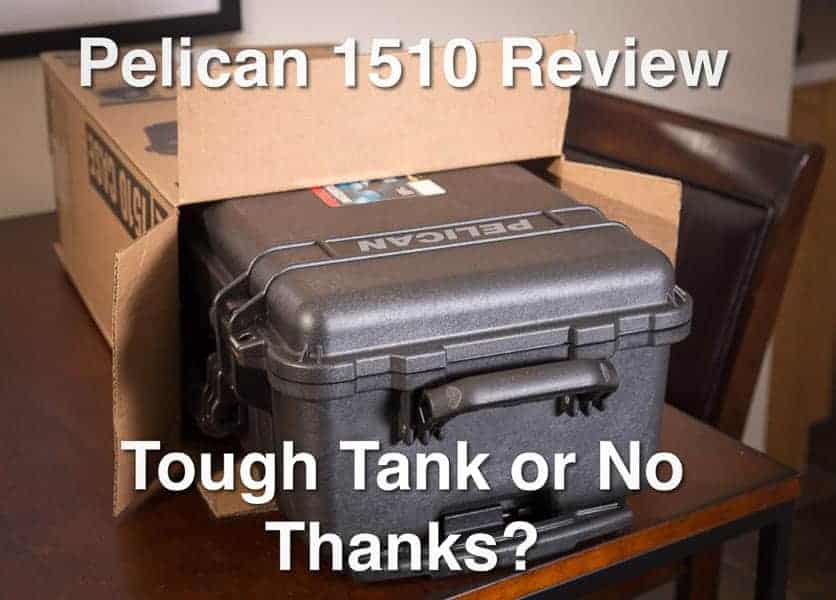 Gear in transport is gear at risk. Whether we're traveling to the Grand Tetons, the Grand Canyon, or to your grandmother's house, any time photographers put gear on the go, we increase the risk that our gear will fall victim to the laws of probability. Whether by carelessness, by weather or by gravity, it just stands to reason. When we leave our homes or studios, the gear we know and love faces risks from transit, unfamiliar surroundings or a dozen other factors.
Gear in transport is gear at risk. Whether we're traveling to the Grand Tetons, the Grand Canyon, or to your grandmother's house, any time photographers put gear on the go, we increase the risk that our gear will fall victim to the laws of probability. Whether by carelessness, by weather or by gravity, it just stands to reason. When we leave our homes or studios, the gear we know and love faces risks from transit, unfamiliar surroundings or a dozen other factors.
The Pelican 5010 offers protection against the risks that come with transportation, weather, and our own carelessness. It's strong and sturdy on the outside, with plenty of cushion for a reasonable amount of gear on the inside. While neither lightweight nor inexpensive, the 5010 is a great option for gear protection.
It's almost a misnomer to review the Pelican 5010. Pelican's retailers have have denoted several (at least six) different variations. All are billed as having the same interior dimensions of 19.75″ H x 11.00″ W x 7.60″ D, but they differ in their particular target market. Are you comfortable with traditional camera bag padding and dividers? What about customized foam? Are you going to want to carry a laptop computer in there as well? Are you going to need a large side compartment where you can put your flugelhorn? Well that's too bad, this case doesn't have one. But pretty much any other kind you'd like can be accommodated.

Oddly, the variant of the 1510 that I tested is also branded as the 1514 (with foam in the top space and padded divider in the lower area). I spoke with Pelican customer service, who assured me that this variant is also sold as the 1510 and its dimensions were identical.
The most prevalent feature is shown in Pelican's own branding of the product as the “1510 Carry-On Case,” and all but one variant claims that it meets the FAA's maximum carry-on size. So if you're considering the 1510, you could do worse than give some advance grey-matter processing to a few of the following questions:
- Do you want to carry a notebook or tablet computer in the case?
- What type of protective surface do you want inside the case (foam, cloth padding, etc.)?
- How much re-configuration do you intend to do in the future as you add more gear?
- Is an exact carry-on size a key feature, or would you rather have oversized wheels for easier rolling over rough surfaces?
- Would a cheaper alternative be a good idea?
Gear Capacity
Though it does not hold all my gear–you're not going to get a standard umbrella in there–I was pleased that it held the essentials. The picture below shows the gear I placed in the case recently. As you can see, it's not maxed out yet.

I ordered my 1510 with the traditional padded inserts–not the foam and not the Pelican-brand TrekPak dividers. This served my needs for two reasons. The first is familiarity. The simple Velcro®-style design matches the style I'm used to using inside my photo gear backpacks. If I would ever need to swap in longer or shorter pieces, I could easily borrow from backpacks I already have. Second, both the all-foam style and the TrekPak designs require some semi-permanent customization. While Pelican and other retailers are happy to sell you more of either material, I suppose I've reached the stage in my gear-carrying relationship where I'm afraid of commitment. For $200 bones (give or take for configuration and special prices), I didn't want to take a chance having to buy additional parts later.
To be fair, I also don't own any $8,000 lenses, which might prompt me to want a full 4″ of foam all the way around. The TrekPak also boasts a super-thin design that could allow for some extra gear if that's the critical factor for you. If you were considering the Pelican 1510 and you knew exactly what you wanted to tote around in it, and this was unlikely to change, then you might prefer the other materials.
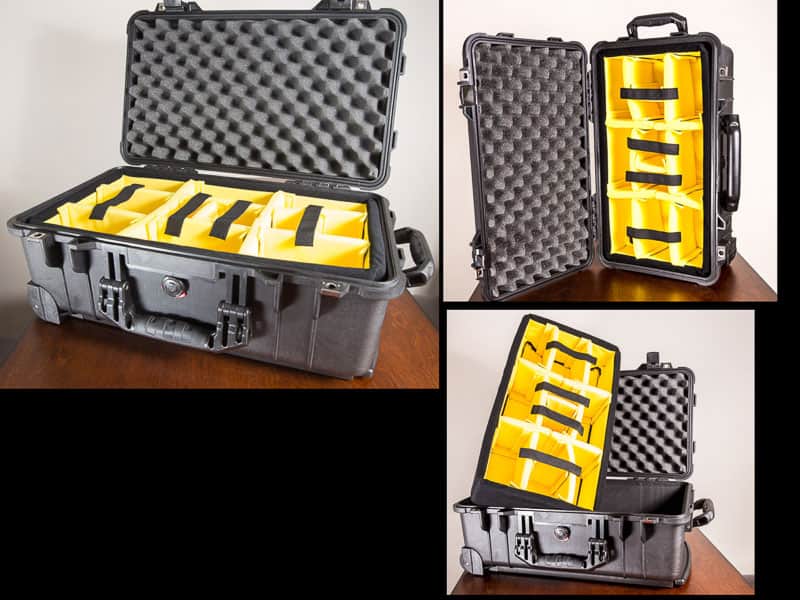 As mentioned, the lid area can be reconfigured to fit a notebook or tablet computer instead of the full foam top. The main drawback here seems to be that you have to get inside such a robust and protective case to get access your computer. This might reveal a bit more about its contents than you had planned on. As for me, I'm pretty sure I've been diagnosed with travel-induced ADHD. I have my iPad out almost constantly when I'm flying, so I think I'd rather not pack it away. This brings up a necessary shortcoming of the 1510. There are no external containers, pockets, or other places for quick access. You won't be sliding your boarding pass or passport into a side pocket here.
As mentioned, the lid area can be reconfigured to fit a notebook or tablet computer instead of the full foam top. The main drawback here seems to be that you have to get inside such a robust and protective case to get access your computer. This might reveal a bit more about its contents than you had planned on. As for me, I'm pretty sure I've been diagnosed with travel-induced ADHD. I have my iPad out almost constantly when I'm flying, so I think I'd rather not pack it away. This brings up a necessary shortcoming of the 1510. There are no external containers, pockets, or other places for quick access. You won't be sliding your boarding pass or passport into a side pocket here.
In terms of packing choices, my priorities are going to be different than yours. But I think most of us are going to face a fork in the road: squeeze a small tripod in (and sacrifice other gear) or leave the tripod out and carry it someplace else. I'm not planning to put my tripod inside this pack, probably ever. Why not? Because for me, a sturdy tripod packed inside a Pelican case is a bit like wrapping a Louisville Slugger in bubble wrap. Why waste precious (and expensive) storage space on an item that should not be so fragile that it requires the white-glove treatment? Sure, you could do it (with the right tripod), but in my opinion it's a waste of space.
Size
Obviously Pelican is not the only manufacturer of hard-sided cases. But it has achieved a brand recognition and design identity that is nearly synonymous with the category. Just as Fitbit and Yeti describe fitness trackers and super-efficient cooler brands, they also have consumer recognition that dominates their category.
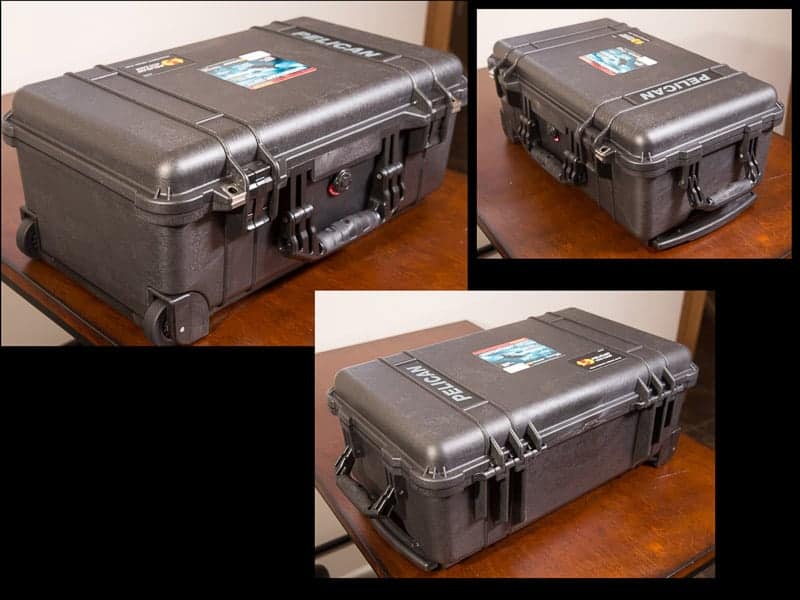 Pelican and its competitors make all manner of sizes, from 50″ behemoths to carry from long guns to a micro-sytle case to put a small cell phone or generation 1 iPod Nano into. The 5010 markets itself as a carry-on size. But it's also ideal for the car. I like to place it in the back seat. With gear, its weight makes sliding around nearly impossible. Since the gear in the compartments stays put, it's easier to access from the front seat while the car's moving. (Yes, Mom. I mean from the passenger seat).
Pelican and its competitors make all manner of sizes, from 50″ behemoths to carry from long guns to a micro-sytle case to put a small cell phone or generation 1 iPod Nano into. The 5010 markets itself as a carry-on size. But it's also ideal for the car. I like to place it in the back seat. With gear, its weight makes sliding around nearly impossible. Since the gear in the compartments stays put, it's easier to access from the front seat while the car's moving. (Yes, Mom. I mean from the passenger seat).
In a small to mid-sized car, the 5010 covers one rear passenger space and most of the center space between the rear passenger seats. So don't count on getting two people in the back seat in addition to the 5010, unless you have a wide pickup or SUV. This assumes the case is placed across the rear seat. I can attest that the 2008 Jeep Wrangler has narrow rear seats, so this is my only option. But with a deeper rear seat (or if you put the case in a front passenger seat), it's possible to lay it lengthwise, so that it would open to the driver's side of the car, rather than to the front of the car.
Weight
The weight of the 5010 empty (or with only a foam or other insert) as shown in the chart above, could be useful information if you're used to using a backpack and want to compare it to the weight of your current typical gear load by adding the “empty” weight to what you use now and presuming the backpack weight is roughly equal to the 5010's interior foam or other partition material weight.
How much you are comfortable lifting in a case like this is, of course, a matter of personal preference. But any case that's designed to be rolled long distances, and only carried short ones, should be evaluated on that basis. It is easily the sturdiest and strongest piece of luggage I own. If any other carry-on in my closet had as much weight as the Pelican 1510 is designed to haul, I fear it would split open like a plastic grocery bag. You will dislocate your shoulder before the Pelican signals it's had enough.
Exterior Features
The three handles–side, end, and extended for rolling– are thick hard-sided Polypropylene like the body, not a strap, or flimsy plastic add-on. I have packed one of my backpacks so full of heavy lenses that I always lift in gingerly, eyeballing the seams at the right shoulder to make sure I'm not going to have a disaster. All of the pins in the Pelican 1510 is stainless steel–an important feature for a weatherproof case. You wouldn't want a rusted hinge pin in the handle to snap when you're hauling 45 pounds of camera gear up the stairs.
The extended handle comes out and retracts easily. Its wide stalk feels like it would easily hold the weight of a second back in transit. There is a release for the extended handle, but it's not built as a button into the handle as it is with many conventional carry-on luggage pieces. Rather, the release is built into the back of the case, several inches lower than the handle. The benefit of this design is that it won't slide open like a greasy trombone if the case is inverted. The drawback is that it would be difficult to extend this handle without two hands–one to hold the release and the other to pull. (Greasy Trombone would be a fantastic name for a band, by the way. You're welcome.)
I had absolutely problem with the wheels on this case. I dropped it about three feet into the mud once and the wheels cleaned off easily and quickly. It is worth nothing that the 1510M (M = Mobility) variant has larger wheels that sit further from the profile. While Pelican observes that this extends the 1510M beyond the standard carry-on size permitted for airline travel, I could certainly see where some photographers find it a worthy trade-off. If you wanted to roll heavy camera equipment along a trail that wasn't as flat as the moving walkway at O'Hare Airport's Terminal C, consider the 1510M. For example portrait photographers, who need to shoot on various regional locations, but don't need to board a 767 to get there, may find the additional ground clearance very helpful–spending less time dragging the case, and more time rolling it.
A few more nice touches are worth noting. Stainless steel padlock protectors–one on each side of the handle–provide a convenient place to add a theft deterrent. A pressure equalization valve, designed to prevent pressure differentials at altitude or depth that could make the case difficult, or even impossible to open, and also somehow keeps water out as well, is mounted next to the handle. Hinged latches (what Pelican calls “Easy throw”) allow both latches to be closed without applying much pressure. This takes a bit of getting used to, because the latches can look closed, when they actually need to be pushed one more notch down. Someone in a hurry with a new case could easily mistake it for closed.
Water Resistance
The 5010 is marketed as “watertight, crushproof and dustproof.” Let's take those in reverse order. I know the ravages of dust can be a problem with photo gear, but most any container can prevent dust on a camera. So could my Indianapolis Colts hat. (At least that way I'd know the Colts could cover something this year!) And while it's nice not to obsess over whether your soft-sided photo backpack is the one at the bottom of the pile in the trunk, there are other hard-sided cases on the market that don't charge the premium that Pelican charges. Determining whether these are really as tough requires some invasive testing techniques that are, frankly, beyond my budget. But Pelican posted some pretty convincing, if promotional, videos of torture tests of some cases. I won't belabor the relative strengths of various polymers and injection molding techniques because you should save that for when you have trouble sleeping.
So, at the risk of being dismissive, I think that the water resistance is the other dominant feature that would attract the eye of most consumers. It also lends itself to a totally unscientific test I can perform without ruining my new case. To start, I simply used a large paper towel, which would easily show moisture and placed it over the padded inserts in the case. Next, I hung the case from a tree and blasted it with water from a hose. (I told you this was unscientific). I concentrated the stream on the “O-Ring” areas where the lid and the bottom of the case come together.
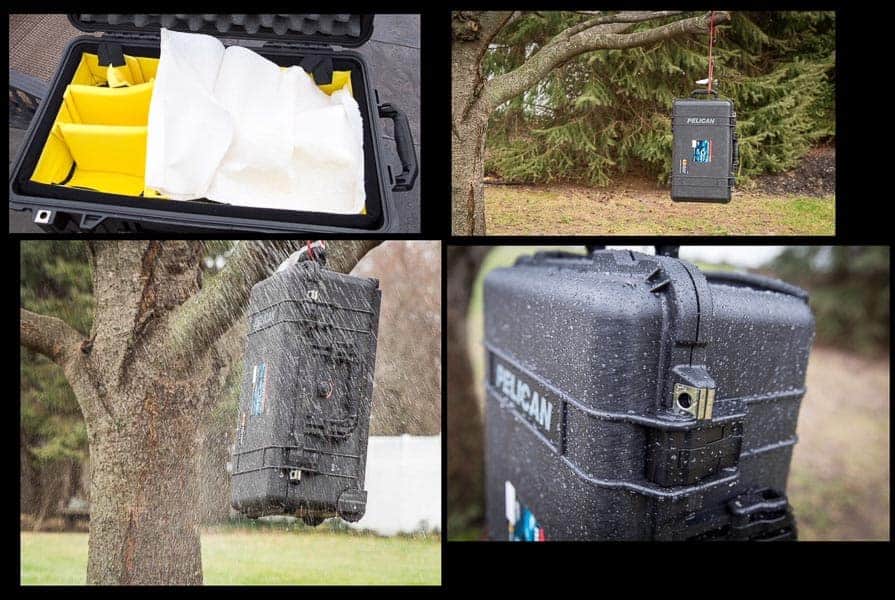
When I was done, and satisfied it couldn't get any wetter, I checked the paper towel. As expected, it was still bone dry. The combination of the O-Ring and the grip of the latches held up.
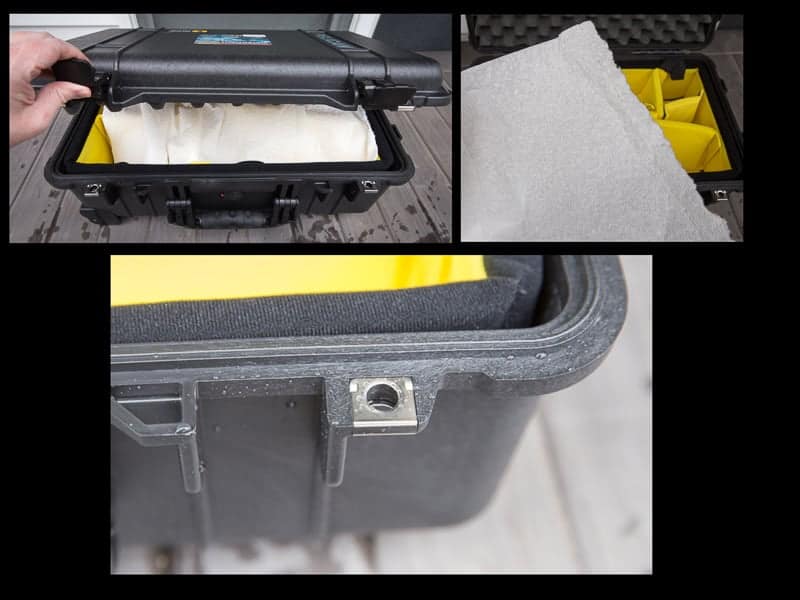
Frankly, it's the strength and water-resistant nature of the case that makes it so attractive. In my opinion, if this isn't effective, it's simply not worth the cost. So as far as I could tell, this part works. Had it not, Pelican has a lifetime warranty and I would've made good use of it.
Decision Point – Pelican 1510 v. Backpack
So when will I take a Pelican and when will I take a backpack? Here's how I see it.
Backpack only: If I'll only need 2 lenses and 1 camera body and a few small add-ons like an extra battery and filter; if I'm only going to be gone a few hours; if I won't be packing a ton of other things in the car that can shift weight and turn that new pancake lens into, well, a pancake.
Pelican only: If I have plenty of space to switch gear, either from the car, or from my destination; if travel surfaces from parking spot to the shooting destination are smooth and not far from the parking area; if we're traveling short distances but with a great deal of additional luggage; or if I'm flying to a destination and won't have long walks or walks over uneven terrain, to get to the photo location.
Pelican and Backpack: If I'm flying to my destination, but will have multiple photo outings once I get there; or if I simply want to take more gear than I can fit in the Pelican.
I expect that for most trips that require air travel, I'll be using both the Pelican case and a photo-specific backpack, keeping the most fragile and expensive gear in the Pelican.
Conclusion
The Pelican 1510 is a beast. Heavy, sturdy, expensive, and more than capable of giving your gear a temporary home for transport. If you don't travel with your gear at all, it's probably overkill.

awesome write up. Super handy too as i just bought this same case in lime green lol
Thanks, Shane. I saw that they released a new batch of colors. The day I ordered mine on Amazon the black one was about $5.00 cheaper, so frugality won out (at least a little bit).
Pelican cases are the bomb. I have several. They are incredibly durable. They are absolutely worth the money if you are serious about protecting your gear.
I like to be prepared for anything that’s why I chose the 1510M (M for mobility) case. Besides, I hated seeing travellers dragging their cases across rough ground when they bottomed out. The 1510M case is 1510 on steroids! Love it.
Nice review. I just bought one and I realize now that all I can put inside the case is a couple of handkerchiefs :-)) when I am travelling by plane. Max weight allowed in cabin is 7Kg! I wish I would ave paid more attention before purchasing online.
Good case to store gears at home, to travel by car, buses, cruise. But NOT BY PLANE since you want to keep all your valuable gears at hands!:-)
have